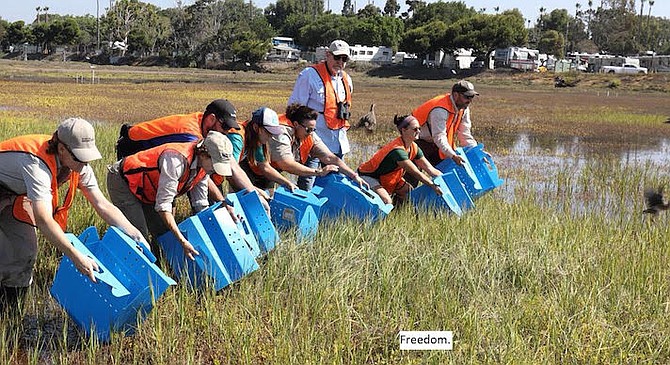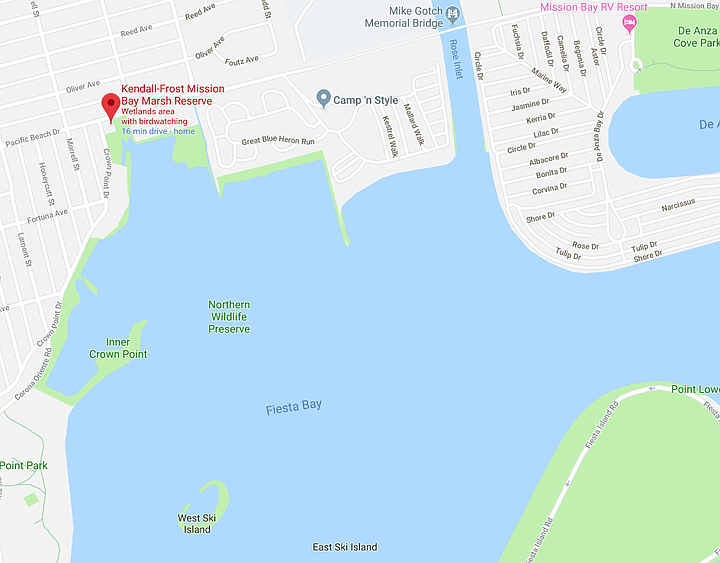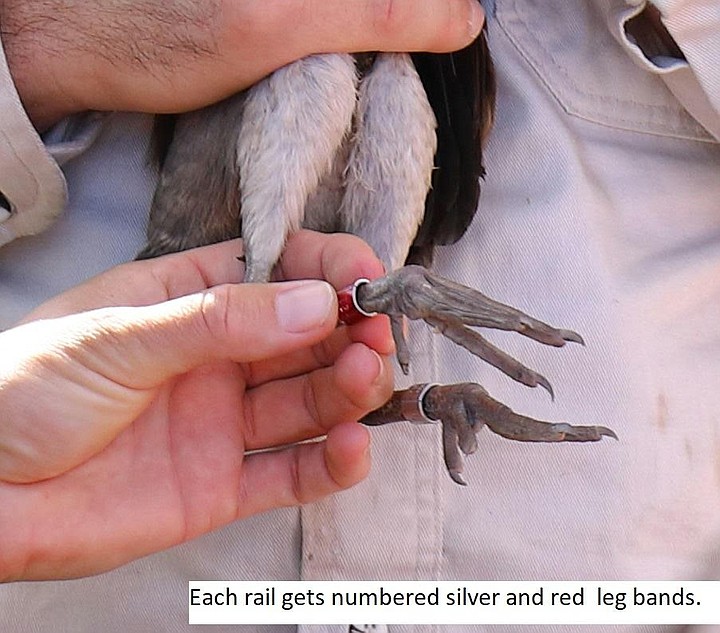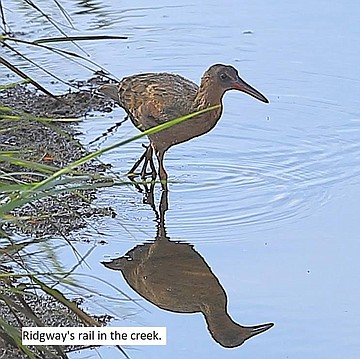 Facebook
Facebook
 X
X
 Instagram
Instagram
 TikTok
TikTok
 Youtube
Youtube

On September 11 at 10 am, eight endangered Ridgeway’s rails birds were released at UC Kendall-Frost Marsh Reserve.

“The rails will help to increase the population of this wetland so that there is a greater chance that at least one breeding pair will survive this winter and will be around to reproduce next breeding season starting next February,” said Isabelle S. Kay, manager of the marsh reserve.

The light-footed Ridgway’s rail is a marsh bird that measures approximately 14 inches long and has long legs and toes. It’s tail is upturned and beak is curved downwards.

“Ridgway’s rails are highly secretive and don’t fly very well,” Kay said. “They use dense vegetation to cover their foraging and nesting movements.”
The marsh reserve is located on the northern edge of Mission Bay to the east of Crown Point Drive and south of Pacific Beach Drive. It occupies 16 acres of the 40 total acres of wetland habitat that includes the adjacent Northern Wildlife Preserve owned by the City of San Diego.
According to the U.S. Fish & Wildlife Service website: “Destruction of coastal wetlands in southern California has been so extensive that many estuaries where light-footed Ridgway’s rails were once abundant have been reduced to remnants. Although salt marsh habitat loss, degradation, and fragmentation are the leading threats to these rails, they are also threatened by disturbance, diseases, contaminants, and predation by non-native red foxes, feral cats, crows, and some raptors.”
Aubry lives north from the marsh reserve in Pacific Beach. “I think that any noise pollution and water pollution affects the ecology of the marsh,” she said. “When Sea World limited the fireworks, that was a big win for all the birds and habitats.”
Kay agreed. “Birds in general are distracted and more susceptible to predation when there is noise and motion in their vicinity,” she said. “Jet boats have been known to crash into the marsh itself, with one several years ago nearly missing a nesting platform. There was damage to the rail habitat (cordgrass).”
Then there’s the “fuel and oil leakage into the bay” from the boats and jetskis … and in the last couple of years, drones have been more affordable.
“Drones are not allowed to be flown over the marsh without approval of the FAA and the UC Natural Reserve System,” Kay said. “However, recreational drones may have been entering the area illegally, in which case it is pretty certain that rails would be intimidated by something they would perceive as a predatory threat, and would interrupt their normal activity.”
Half a mile to the east from the marsh reserve office is Campland on the Bay, a recreational vehicle (RV) and tent camping resort. “I heard that Campland’s lease was extended (for five years) because it’ll still be a few years before construction begins,” Aubry said. “We’d love to see Campland turn into more marsh.”
“If wetland habitat is expanded to the entire Campland area, it will benefit the rails tremendously,” Kay said. “First, fresh water and sediment from Rose Creek will be able to enter the wetland – as it did historically – and will help to rebuild the existing marsh habitat, which appears to be sinking due to decomposition that causes compaction. Areas of the marsh now hold standing water, which drowns even the saltmarsh plants, leaving bare areas lacking vascular plants.”
Many residents don’t agree with the proposals of ridding the 49-year-old affordable waterfront camping site: including Terri Campbell and Sean Schwab from Friends of Campland, “a group of fellow campers, including San Diego residents and families, and campers from all over North America, that have joined together to help save Campland on the Bay and access to waterfront camping on Mission Bay.”
Campbell started an online petition that reads in part. “We, the undersigned, wholeheartedly support Campland on the Bay and the preservation of waterfront RV camping on Mission Bay. To be delivered to Craig Hooker, City of San Diego Park Planning, Planning Department and Park Designer.”
The petition has garnered almost 3,800 signatures as of presstime.


On September 11 at 10 am, eight endangered Ridgeway’s rails birds were released at UC Kendall-Frost Marsh Reserve.

“The rails will help to increase the population of this wetland so that there is a greater chance that at least one breeding pair will survive this winter and will be around to reproduce next breeding season starting next February,” said Isabelle S. Kay, manager of the marsh reserve.

The light-footed Ridgway’s rail is a marsh bird that measures approximately 14 inches long and has long legs and toes. It’s tail is upturned and beak is curved downwards.

“Ridgway’s rails are highly secretive and don’t fly very well,” Kay said. “They use dense vegetation to cover their foraging and nesting movements.”
The marsh reserve is located on the northern edge of Mission Bay to the east of Crown Point Drive and south of Pacific Beach Drive. It occupies 16 acres of the 40 total acres of wetland habitat that includes the adjacent Northern Wildlife Preserve owned by the City of San Diego.
According to the U.S. Fish & Wildlife Service website: “Destruction of coastal wetlands in southern California has been so extensive that many estuaries where light-footed Ridgway’s rails were once abundant have been reduced to remnants. Although salt marsh habitat loss, degradation, and fragmentation are the leading threats to these rails, they are also threatened by disturbance, diseases, contaminants, and predation by non-native red foxes, feral cats, crows, and some raptors.”
Aubry lives north from the marsh reserve in Pacific Beach. “I think that any noise pollution and water pollution affects the ecology of the marsh,” she said. “When Sea World limited the fireworks, that was a big win for all the birds and habitats.”
Kay agreed. “Birds in general are distracted and more susceptible to predation when there is noise and motion in their vicinity,” she said. “Jet boats have been known to crash into the marsh itself, with one several years ago nearly missing a nesting platform. There was damage to the rail habitat (cordgrass).”
Then there’s the “fuel and oil leakage into the bay” from the boats and jetskis … and in the last couple of years, drones have been more affordable.
“Drones are not allowed to be flown over the marsh without approval of the FAA and the UC Natural Reserve System,” Kay said. “However, recreational drones may have been entering the area illegally, in which case it is pretty certain that rails would be intimidated by something they would perceive as a predatory threat, and would interrupt their normal activity.”
Half a mile to the east from the marsh reserve office is Campland on the Bay, a recreational vehicle (RV) and tent camping resort. “I heard that Campland’s lease was extended (for five years) because it’ll still be a few years before construction begins,” Aubry said. “We’d love to see Campland turn into more marsh.”
“If wetland habitat is expanded to the entire Campland area, it will benefit the rails tremendously,” Kay said. “First, fresh water and sediment from Rose Creek will be able to enter the wetland – as it did historically – and will help to rebuild the existing marsh habitat, which appears to be sinking due to decomposition that causes compaction. Areas of the marsh now hold standing water, which drowns even the saltmarsh plants, leaving bare areas lacking vascular plants.”
Many residents don’t agree with the proposals of ridding the 49-year-old affordable waterfront camping site: including Terri Campbell and Sean Schwab from Friends of Campland, “a group of fellow campers, including San Diego residents and families, and campers from all over North America, that have joined together to help save Campland on the Bay and access to waterfront camping on Mission Bay.”
Campbell started an online petition that reads in part. “We, the undersigned, wholeheartedly support Campland on the Bay and the preservation of waterfront RV camping on Mission Bay. To be delivered to Craig Hooker, City of San Diego Park Planning, Planning Department and Park Designer.”
The petition has garnered almost 3,800 signatures as of presstime.
Comments